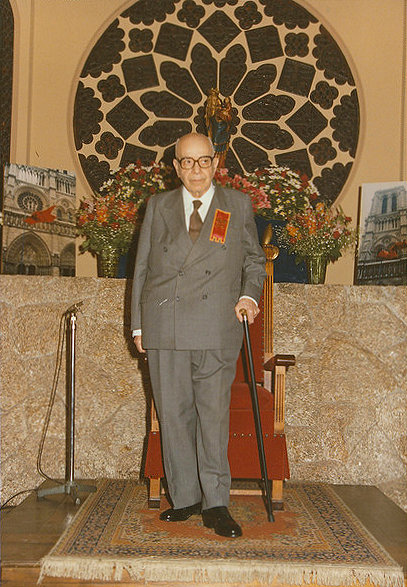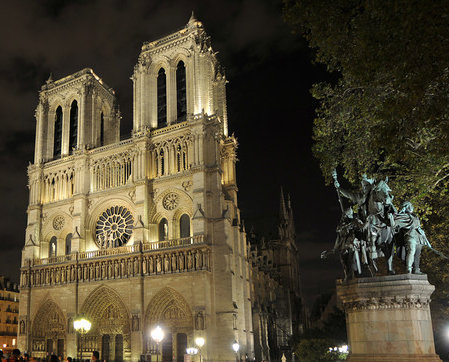By Plinio Corrêa de Oliveira
 I cannot forget how in one of my trips to Paris, evening was falling when I arrived. I had dinner and went immediately to see Notre Dame. It was a summer evening, but not an extraordinarily beautiful one. The cathedral was all lit up and as my car crossed from the left bank of the river Seine onto the island, I saw the cathedral from a side, a perspective that was completely fortuitous. If the haphazard exists—and in a certain sense it does—I would say that I was instantly surprised by the cathedral in a haphazard way. I gazed and found it so beautiful that I felt like saying to the driver, “Stop! I want to stay right here. I know the rest of it is very beautiful, but I believe that few souls ever stopped to look at the cathedral from this vantage point; and I want to be among the few to render praise to Our Lady from this perspective that others perhaps did not praise sufficiently. At least it will be said that there was once a pilgrim from afar that loved what many others did not love, because they were in a hurry, or perhaps because they did not receive a special grace at that moment.”
I cannot forget how in one of my trips to Paris, evening was falling when I arrived. I had dinner and went immediately to see Notre Dame. It was a summer evening, but not an extraordinarily beautiful one. The cathedral was all lit up and as my car crossed from the left bank of the river Seine onto the island, I saw the cathedral from a side, a perspective that was completely fortuitous. If the haphazard exists—and in a certain sense it does—I would say that I was instantly surprised by the cathedral in a haphazard way. I gazed and found it so beautiful that I felt like saying to the driver, “Stop! I want to stay right here. I know the rest of it is very beautiful, but I believe that few souls ever stopped to look at the cathedral from this vantage point; and I want to be among the few to render praise to Our Lady from this perspective that others perhaps did not praise sufficiently. At least it will be said that there was once a pilgrim from afar that loved what many others did not love, because they were in a hurry, or perhaps because they did not receive a special grace at that moment.”
 And at all the great monuments of Christendom, after admiring their marvels, it is my tendency to admire their details in an act of reparation; for perhaps those details were not loved as they should have been. And thus, to do at least this: To love what should have been loved but was forgotten. It is always our vocation to bring to the forefront those forgotten truths set aside by men. I was enchanted with the cathedral from that angle. Then I walked around and returned to the hotel with my soul filled to the brim. If at that moment anyone had repeated the words of Scripture, “Behold the church of perfect beauty, the joy of the whole world,” I would have said: “Ah yes! How well formulated this is. It is exactly how I feel towards this cathedral.”
And at all the great monuments of Christendom, after admiring their marvels, it is my tendency to admire their details in an act of reparation; for perhaps those details were not loved as they should have been. And thus, to do at least this: To love what should have been loved but was forgotten. It is always our vocation to bring to the forefront those forgotten truths set aside by men. I was enchanted with the cathedral from that angle. Then I walked around and returned to the hotel with my soul filled to the brim. If at that moment anyone had repeated the words of Scripture, “Behold the church of perfect beauty, the joy of the whole world,” I would have said: “Ah yes! How well formulated this is. It is exactly how I feel towards this cathedral.”
 And then, from the depth of our souls, from the depth of our innocence, something else rises. It is a light, a super light, but at the same time a penumbra or obscurity without darkness; and it is the idea that all of the world’s Gothic cathedrals, those that were built and those that were not, convey as an ensemble an idea of God, Who nevertheless is infinitely more than all that. At this the mentality that inspired all of those cathedrals appears to us and then truly we live more in Heaven than on earth.
And then, from the depth of our souls, from the depth of our innocence, something else rises. It is a light, a super light, but at the same time a penumbra or obscurity without darkness; and it is the idea that all of the world’s Gothic cathedrals, those that were built and those that were not, convey as an ensemble an idea of God, Who nevertheless is infinitely more than all that. At this the mentality that inspired all of those cathedrals appears to us and then truly we live more in Heaven than on earth.
 Hence our desire for a different life, to know Another, with a capital “A”, Who is so entirely within me that He is more myself than I, but so superior that I am not even a speck of dust compared to Him… And then I understand that Heaven must be like this. We love even more that most pure, eternal and invisible spirit Who created all of this in order to say, “My son, I exist. Love Me, and understand that this is similar to Me, but above all understand that as beautiful as this is I am infinitely different from this; mine is a form of beauty so quintessential and superior, that only when you see Me will you fully realize Who I am.
Hence our desire for a different life, to know Another, with a capital “A”, Who is so entirely within me that He is more myself than I, but so superior that I am not even a speck of dust compared to Him… And then I understand that Heaven must be like this. We love even more that most pure, eternal and invisible spirit Who created all of this in order to say, “My son, I exist. Love Me, and understand that this is similar to Me, but above all understand that as beautiful as this is I am infinitely different from this; mine is a form of beauty so quintessential and superior, that only when you see Me will you fully realize Who I am.
 Come, My son, come because I am waiting for you. Fight for a little longer, for I am preparing to show you even greater beauties in Heaven in the measure that your fight is great and hard. Wait, and when everything I intended to show you from the moment I created you is ready, I will say: ‘My son, I am your Cathedral; that Cathedral immeasurably great; that Cathedral immeasurably beautiful; that Cathedral which made a smile flourish on the lips of the Virgin as no jewel ever did, as no rose ever did, as none of the mere creatures She came to know ever did. That Cathedral is Our Lord Jesus Christ. It is the Heart of Jesus, Who drew from the Heart of Mary harmonies like nothing else ever did. Then will you come to know Him, Who said: ‘I Myself will be your reward immeasurably great.’”
Come, My son, come because I am waiting for you. Fight for a little longer, for I am preparing to show you even greater beauties in Heaven in the measure that your fight is great and hard. Wait, and when everything I intended to show you from the moment I created you is ready, I will say: ‘My son, I am your Cathedral; that Cathedral immeasurably great; that Cathedral immeasurably beautiful; that Cathedral which made a smile flourish on the lips of the Virgin as no jewel ever did, as no rose ever did, as none of the mere creatures She came to know ever did. That Cathedral is Our Lord Jesus Christ. It is the Heart of Jesus, Who drew from the Heart of Mary harmonies like nothing else ever did. Then will you come to know Him, Who said: ‘I Myself will be your reward immeasurably great.’”








